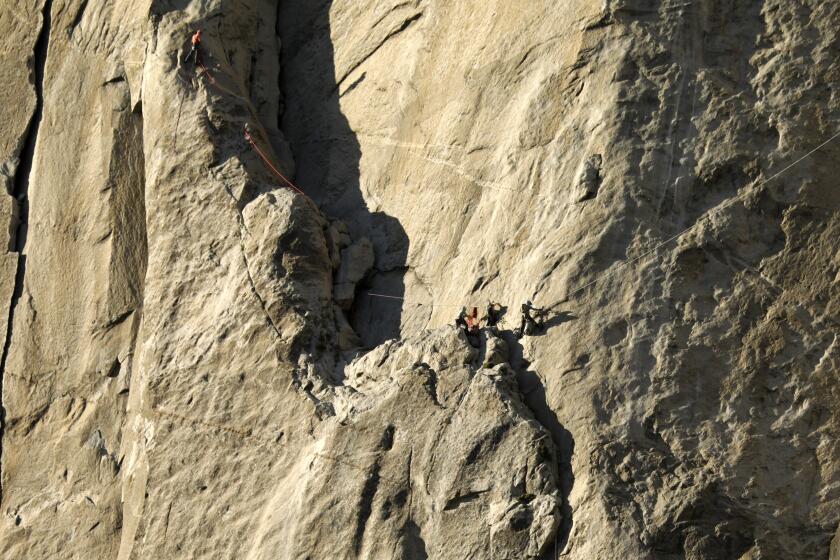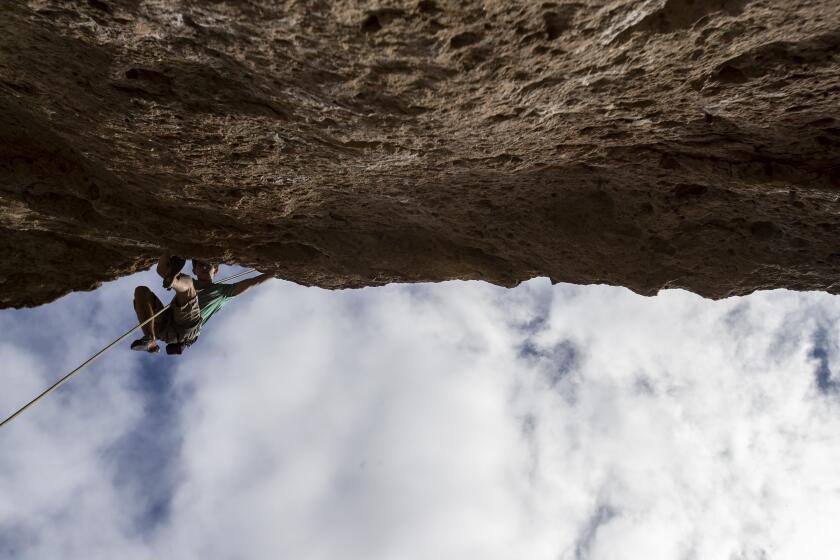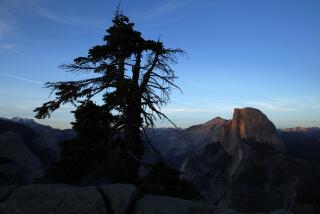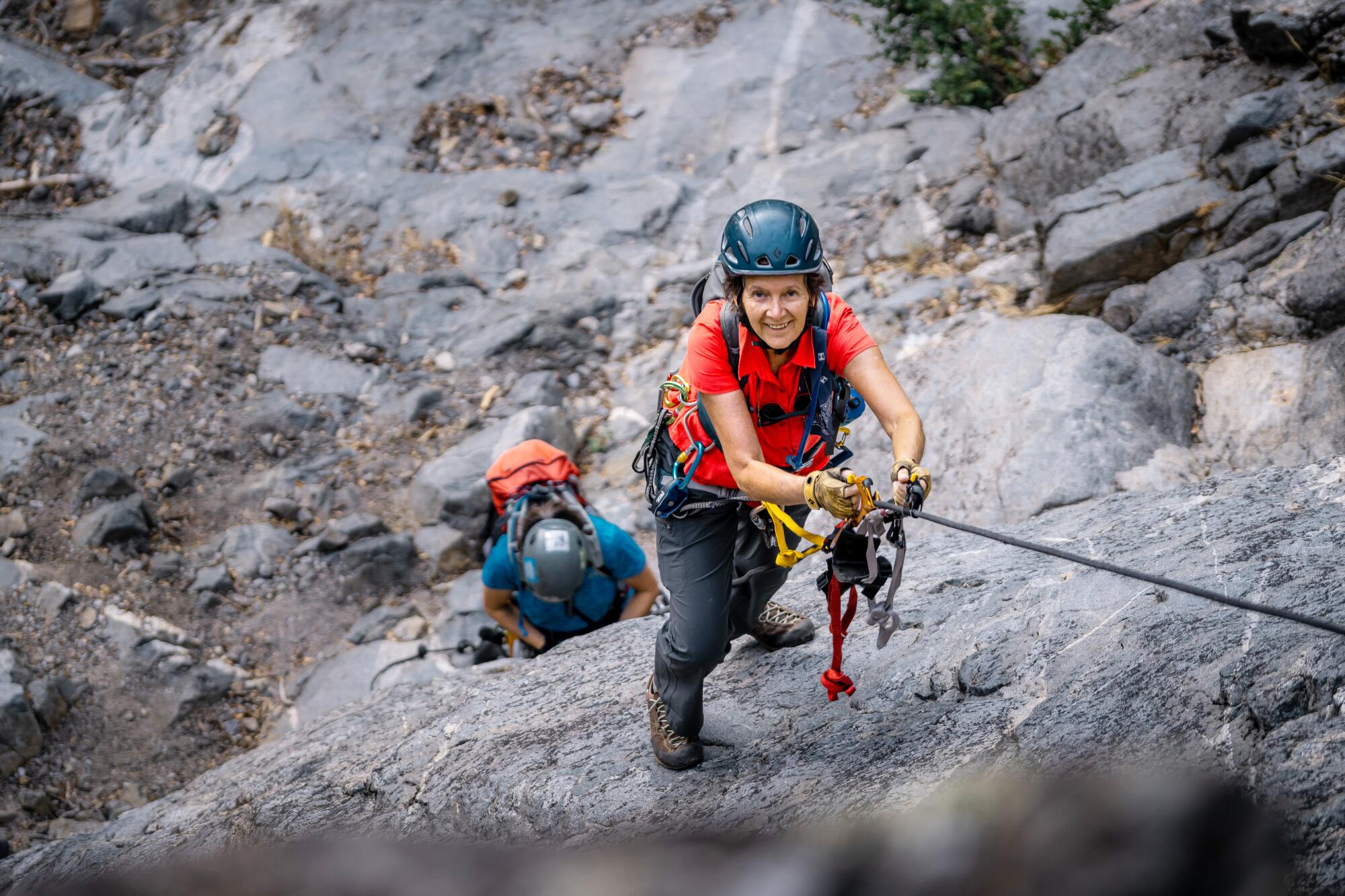
- Share via
SACRAMENTO — The 2018 documentary “Free Solo” celebrates a wide-eyed, shaggy-haired ectomorph named Alex Honnold as he makes history — climbing Yosemite’s El Capitan without ropes or other safety gear. The film and Honnold’s quiet, self-effacing heroism helped transform climbing into a mainstream sport, one featured in the 2020 Olympics.
Yet even before the Academy Award-winning film provided a boost to a once-fringe sport, Honnold had inspired one important greenhorn to get up from her desk and out onto the rocks: his 58-year-old mother, who had never explored her daredevil side during a life as a writer, musician, artist and foreign language teacher.
A dozen years after her son helped propel her renaissance, Dierdre Wolownick last month scaled the face of El Capitan on her 70th birthday, becoming the oldest woman to conquer the 3,000-foot-high expanse of granite that is climbing’s Mt. Everest. The one-time “lumpy old mom,” as she called herself, first set that record four years ago and has continued to finesse her way up several other fabled rock towers, emerging as something of an icon in Yosemite Valley’s climbing community.
It all started in early 2009, when Wolownick decided she had to try climbing if she ever really wanted to get to know her son.
“I wanted to be part of his life, to share his triumphs as well as his disasters,” Wolownick wrote in her 2019 memoir. “Getting outdoors with my son filled in so many gaps in my education. I learned how little I knew about the mountains. About my own possibilities. About him.”
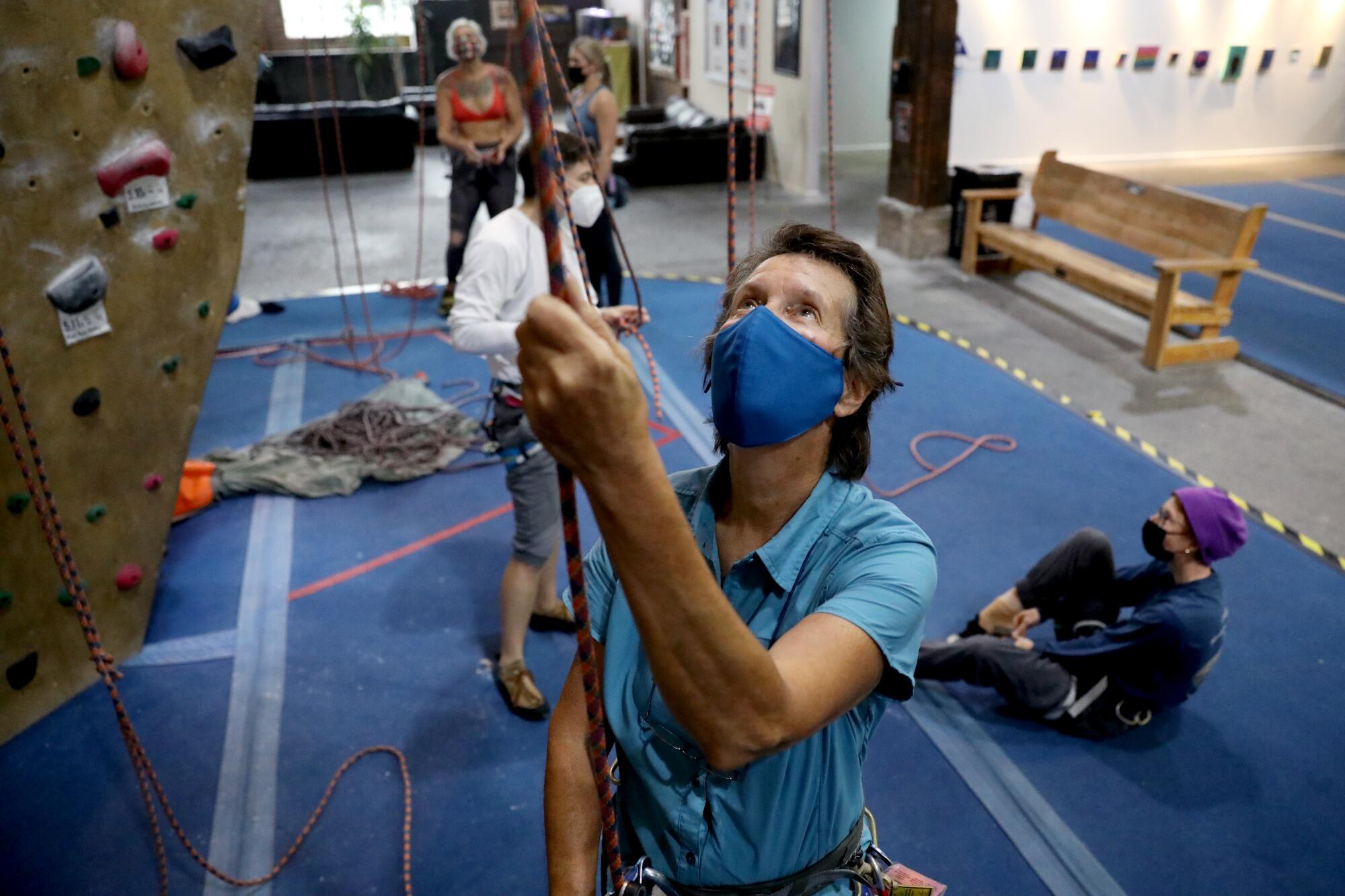
Other seniors — such as Japan’s Yuichiro Miura, who climbed Mount Everest at ages 70, 75 and 80 — have helped redefine what’s athletically possible for those in their golden years. But Wolownick’s attraction to Yosemite’s renowned “big walls,” including her 70th birthday jaunt up “El Cap” in September, has given her a special kind of celebrity. She was featured in USA Today after her birthday climb, profiled this week in the New York Times, as part of a series about people who pursue their dreams on their own terms, and soon will be the focus of the “70 Over 70” podcast, about late-in-life high achievers.
Her famous son and occasional climbing partner, the 36-year-old Honnold, has helped amplify the attention. She’s now in demand as a public speaker, serves as a senior advisor to La Sportiva outdoor wear and draws a small retinue of fellow climbers and admirers when she visits Yosemite Valley. If you run across her there, she might sell you a copy of “The Sharp End of Life: A Mother’s Story,” her 2019 memoir, and tell you how lucky she has been.
“It’s all been an amazing experience, one I never could have dreamed up for myself,” said Wolownick, during a recent workout at Pipeworks, a climbing gym not far from her home in suburban Sacramento. “I used to look at those tiny dots going up that granite wall and wonder what they saw up there and what they felt up there. Now, it’s a whole new world for me. And I want to share that.”
Wolownick had only a cameo role in “Free Solo.” Not revealed in the film was that Honnold’s mother was the author of more than half a dozen books, a one-time community orchestra conductor and, she believes, the source of the stubbornness gene that helped make her son the most acclaimed climber in history.
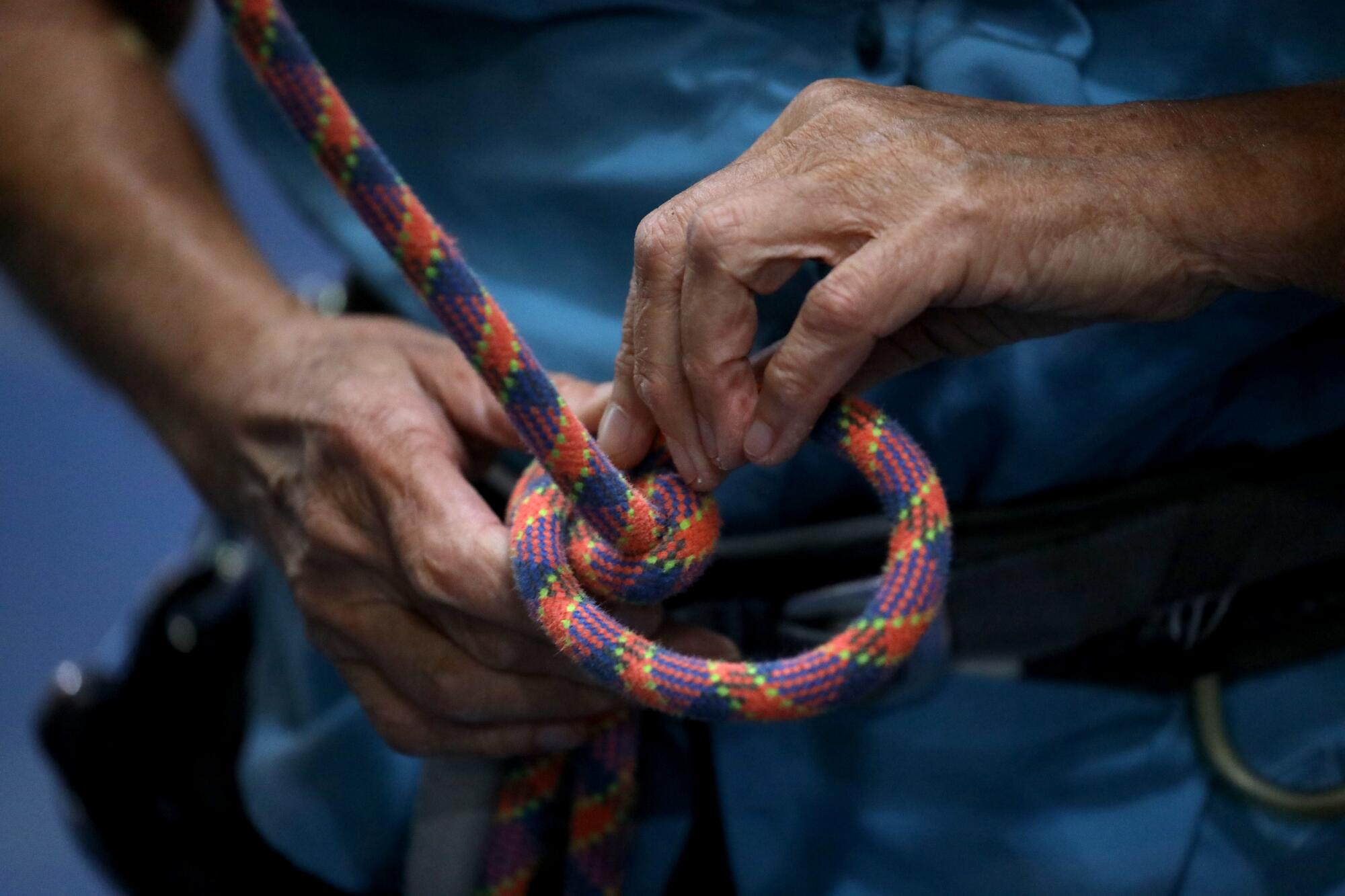
She’s planning to write her next book on how to raise children to be environmentally attuned. And she has the arrival of her first grandchild — from Alex and daughter-in-law Sanni McCandless — to look forward to in February. (There’s also a second wedding ceremony for the couple coming in early November.) But, perhaps most importantly, she’s here to remind others to get off their duffs and out into the world, no matter their ages.
“The most important decision is to start,” Wolownick said. “Once you start and decide you want to do something, it can be powerful. I say, ‘Just try it! Try it! You never know what might happen.’ ” A homemade sign in French in her home office proclaims: “Vouloir, c’est pouvoir.” Rough translation: To want something, is to be able to do it.
The long-time French (and Spanish and Italian and English-as-a-second-language) teacher clearly tries to live that aphorism, as evidenced by her scaling of parts of Half Dome, Cathedral Peak and other intimidating rock monuments, at an age when many people are challenged by a single downward-facing-dog pose.
It wasn’t clear her story would end up this way.
Wolownick writes of the desolation of suburbia and feeling trapped in an unhappy marriage; though thankful her husband was more steady, and even joyful, in the presence of their two children.
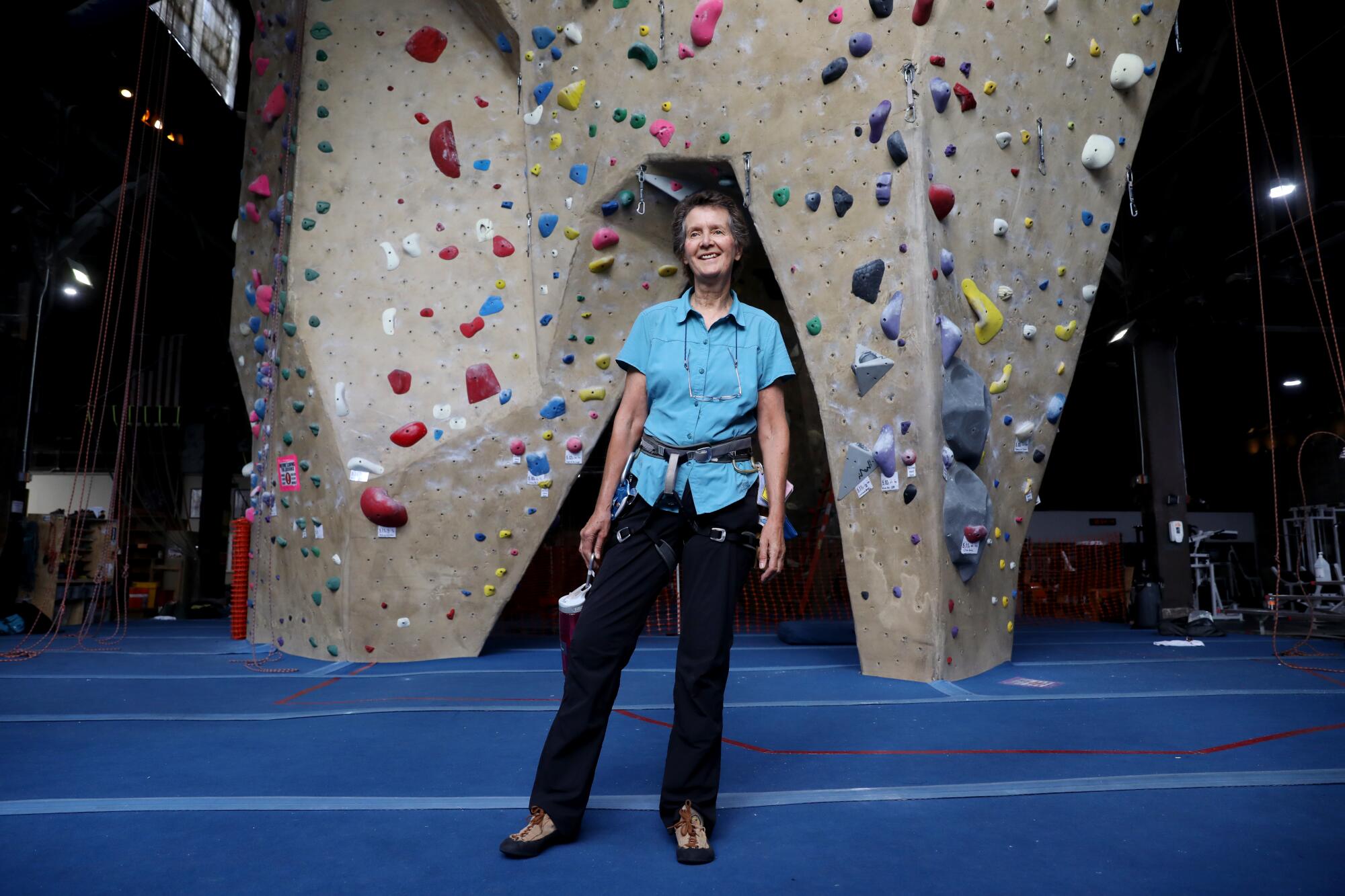
She took up jogging at 55 and gained a measure of fitness. She first ran just one mile, then upped her mileage to 1.5. And so forth. Later she installed a chin-up bar that still fills a doorway in her suburban Sacramento home. (She tries to snap off 10 reps each time she passes the bar and as many as 50 total a day.)
For the record:
2:01 p.m. Oct. 28, 2021An earlier version of this article said Dierdre Wolownick began climbing in 2018. She took up the sport in 2008.
Her climbing odyssey began in late 2008, with Alex home because of an injury and available to accompany her on her first visit to Pipeworks, a cavernous climbing gym north of downtown Sacramento. She had intended to make it an introductory session. But after a first climb, 45 feet up and almost to the ceiling, she was not tired. She ended up doing a dozen climbs that day.
“After about a month of mulling over that initial experience, I finally got the courage to return to the gym alone,” Wolownick recalled. She met one of her best climbing friends that day in early 2009, and committed to the sport for good.
In her book, she acknowledges that she shares “stringy hair and a skinny face” with her famous son, but came to learn on climbing expeditions that they also share another characteristic — deep determination. “We’re both as stubborn as we need to be,” she wrote.
“The Sharp End” of her book’s title is a reference to the climber who is taking the lead and therefore the most responsibility for any expedition. Wolownick has progressed from soft apprentice to a journeywoman capable of taking the “sharp end” of the rope and leading her willing son up vertical granite walls.
“As a mother, I marveled at this process of swapping leads. Parents and children often wind up changing roles in life, as they get older,” she wrote. “But never, I thought, is that transformation as obvious as when they climb together.” The process made her feel like Merlin, the magician who becomes younger with age.
A modest building outside the park holds the history of Yosemite’s climbing greats
Wolownick’s book may be a motivational tract, but it’s not without nuance. She details harrowing hikes into Yosemite’s backcountry, persevering through rock slides, electrical storms, rattlesnakes, a bear (enamored with her water bottle and accompanying pack) and bouts of utter exhaustion and aching self-doubt.
A foray to rugged Matthes Crest is particularly notable for its highs and lows. Reaching the top of the 10,923-foot landmark, Wolownick marvels at her own achievement and seeing her son in his element, bounding and gamboling near the precipice “like a little boy having the time of his life.”
Hiking down from Matthes, long after sunset, the 60-something becomes so completely exhausted that she contemplates simply falling asleep and perhaps quietly (and happily) freezing to death. “My feet refused to move. … I didn’t think of it as dying,” Wolownick wrote. “It would be just another step, something that happened along the way.”
Before she lets herself succumb, Wolownick considers her children and how selfish it would be to deprive them of their mother, when they had lost their father as young adults. (Charlie Honnold had a heart attack and died in an airport in 2004, when his son was 19.) So, after a long regrouping, she sets a hiking pole into the sandy trail. And takes one impossible step. Then another. And another. All the way back to the trailhead.
“Becoming alive had become important again,” she wrote. “It probably always was.”
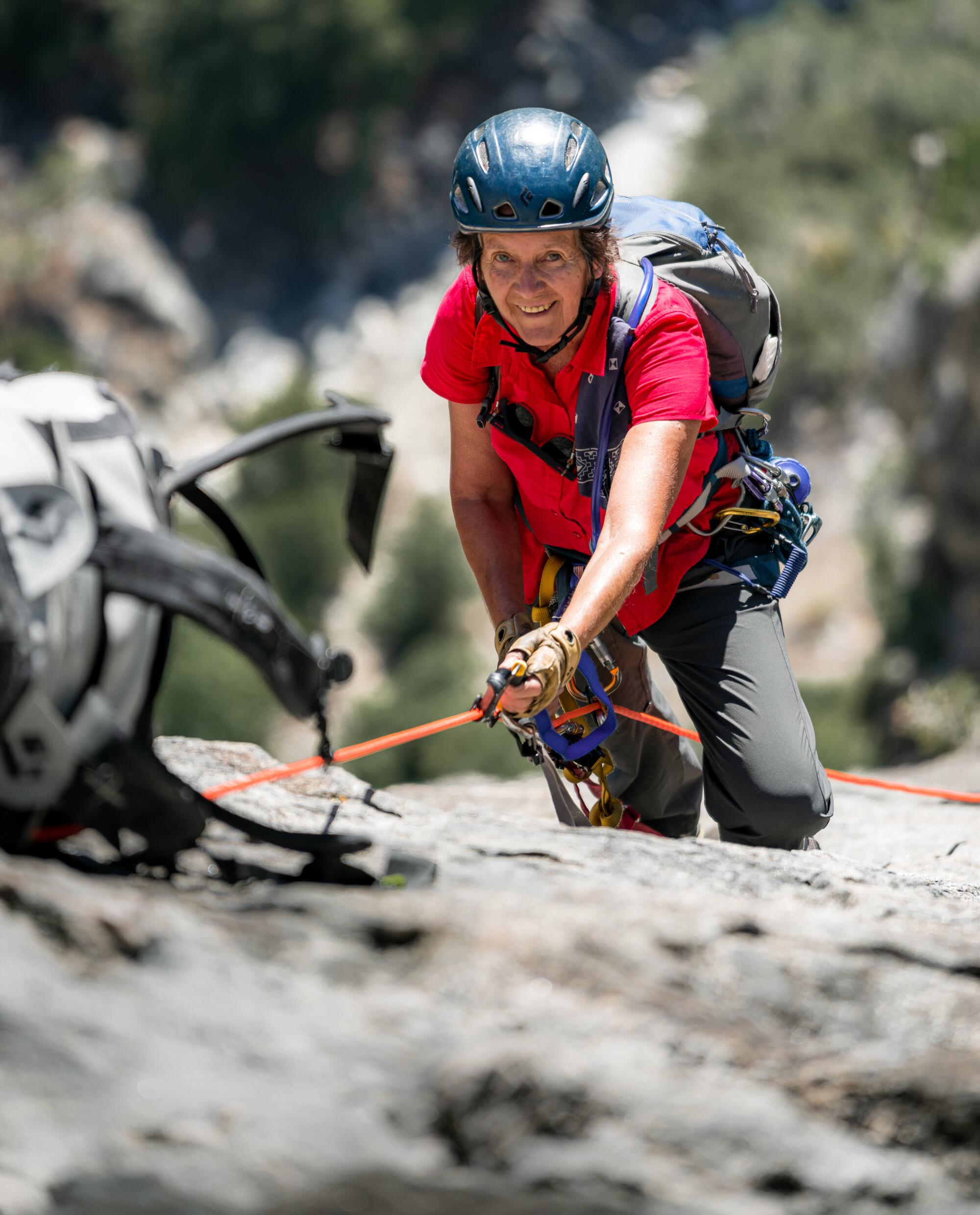
Wolownick’s September climb to the top of El Capitan was led, as typical in her new life, by a new friend. She met Garet McMackin just three months earlier. McMackin is a “dirt bagger,” one of the devotees who has thrown off other earthly wants to commune with the mountains, year round. The van-living, 26-year-old former Marine quickly clicked with the woman old enough to be his grandmother. They began practicing together on the fixed lines on the eastern shoulder of “El Cap,” a relatively forgiving route where she planned to make her 70th birthday ascent. The rock’s so-called Eastern Steps are the pathway almost all climbers used to descend, once they have reached the summit.
Among the others in the party for the birthday climb: 11-year-old Pearl Johnson, a family friend who two years ago briefly held the title of the youngest person (at age 9) to ever climb the slab’s face. Most of the 10-hour ascent on Sept. 23 involved hiking and scrambling over boulders, trees and other obstacles, though the steepest section requires ropes and about 1,000 feet of “jugging” — using mechanical grips to pull up ropes set semi-permanently on the rock.
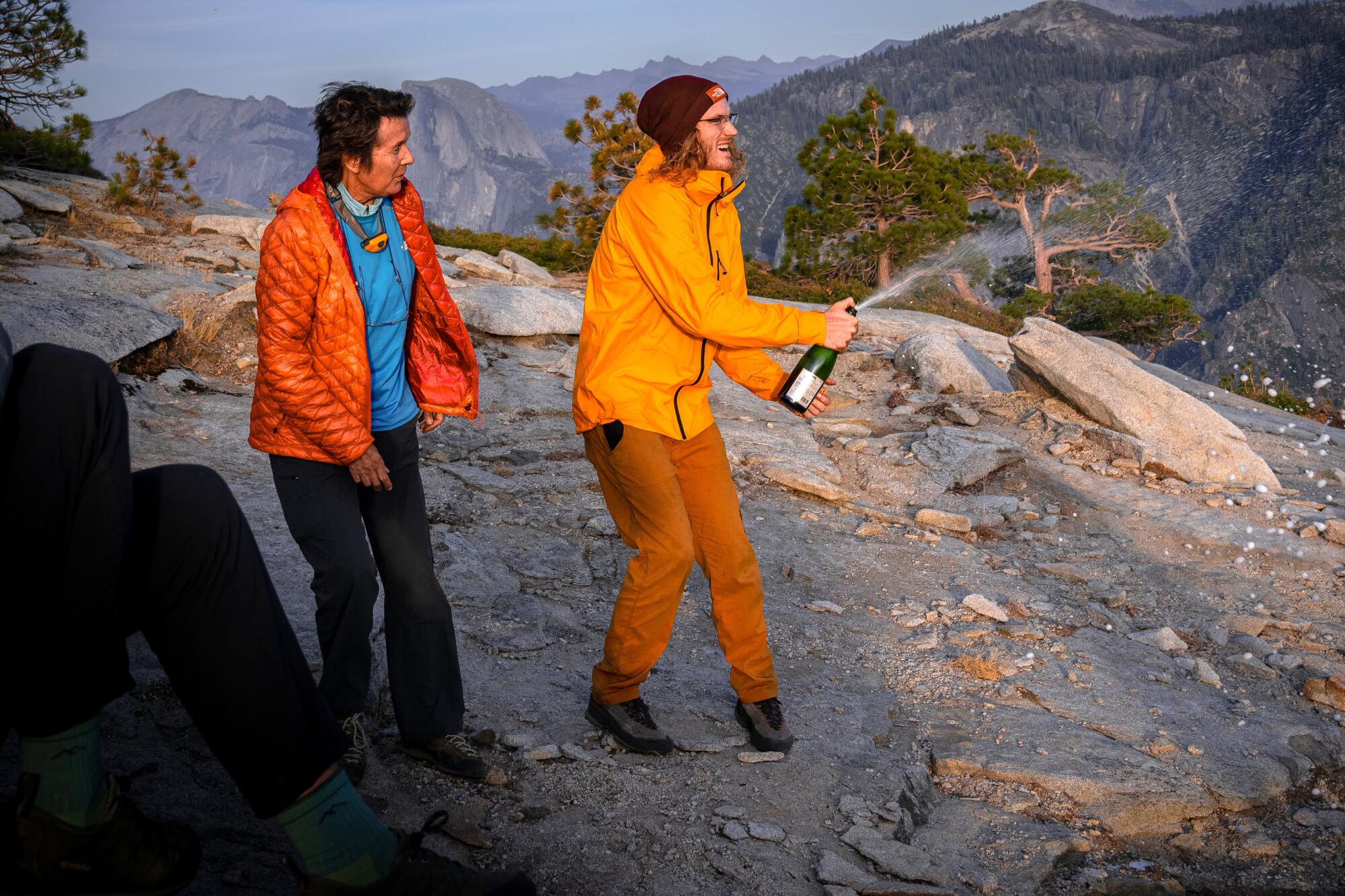
Friends packed in cupcakes and Champagne, which capped a birthday celebration around a glorious sunset. The group slept atop the iconic rock, just feet from the precipice.
“It was really awe-inspiring to watch her and then to have her on top with all of us,” said McMackin. “There was a special look on everyone’s face. We knew where we were. We knew how awesome the moment truly was.”
Wolownick said she is not done for the season. She plans in mid-November to climb about a third of the way up El Cap, to the base of the Heart Formation, an enormous heart-shaped indentation on the great rock’s western face. The climb will mark roughly the fourth anniversary of her 2017 ascent with Honnold, the one that made her the oldest woman ever to scale El Cap. She recalls that 13-hour odyssey as remarkable for many things, including the route they took, named “Lurking Fear,” and the realization that, even more than half a mile above the valley floor, she felt “no queasies, no fear, just amazement at how beautiful it was.”
Rock climbing spots in L.A.
Although not quite the sub-four-hour climb her son completed without gear, Wolonick and Honnold’s one-day assault on the 7,573-foot summit was still a stunner, given her age and inexperience. Experts often take four days (and thus three nights) on the same route.
While Wolownick’s story centers on her personal renaissance, she says repeatedly that none of it would have been imaginable, or enjoyable, without the persistent support of her son and daughter, Stasia, 38, another extreme athlete, who thinks nothing of 1,000-mile bike rides into the American outback, often with backpacking side-treks along the way.
Wolownick speaks just as glowingly of her daughter as her son. She calls Stasia “the peacemaker,” who often helped her negotiate with her bull-headed son over rules and limits on the boy, who began climbing atop things almost before he could walk.
While Alex was delightful and bright, but a handful, Stasia was “my sunny cheering section ... always completely, happily encouraging,” while arranging bike rides or egging her mother on in her marathons and other races.
For her part, Stasia said via email she was grateful “to have grown up with parents who pursued their own passions,” adding: “This is probably inelegantly put, but I feel like she gave us a great example of how to be a full human, not a parent only. Of how to build our own adult lives based on our own values and what’s important to us, and how to put in the work to get to where we want.”
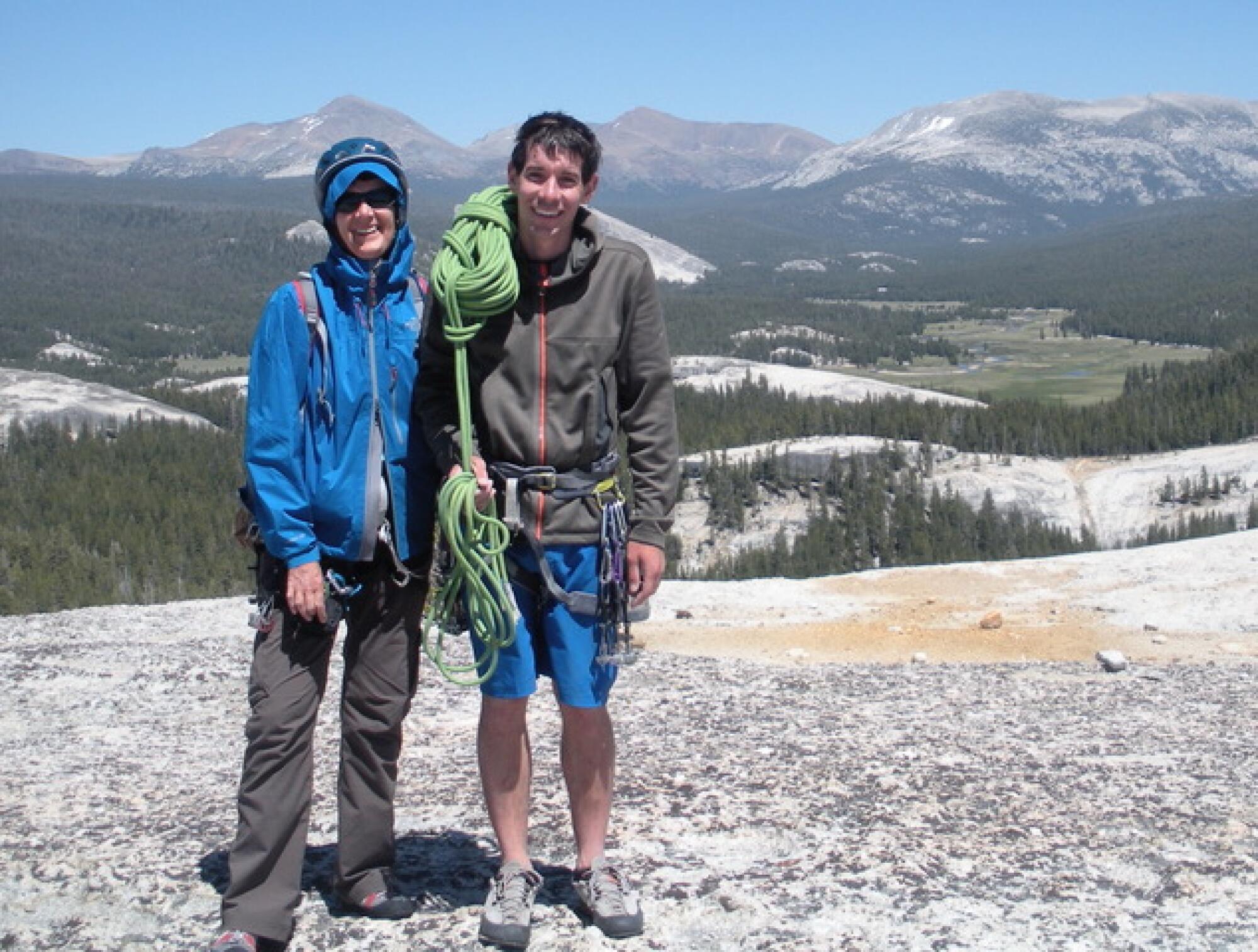
Before her next El Cap moment, America’s most famous climbing mother will attend a second wedding ceremony for her son and McCandless. (The first event, last year, had to be smaller, because of the pandemic.)
The duo’s romance was prominent in “Free Solo,” with the film’s narrative leaving some doubt as to whether McCandless and Honnold — relentlessly focused on his climbing, not romance — would end up together. Wolownick sounds pleased that it all worked out. “Sanni made Alex blossom, and vice versa,” Wolownick said. “So it’s great.”
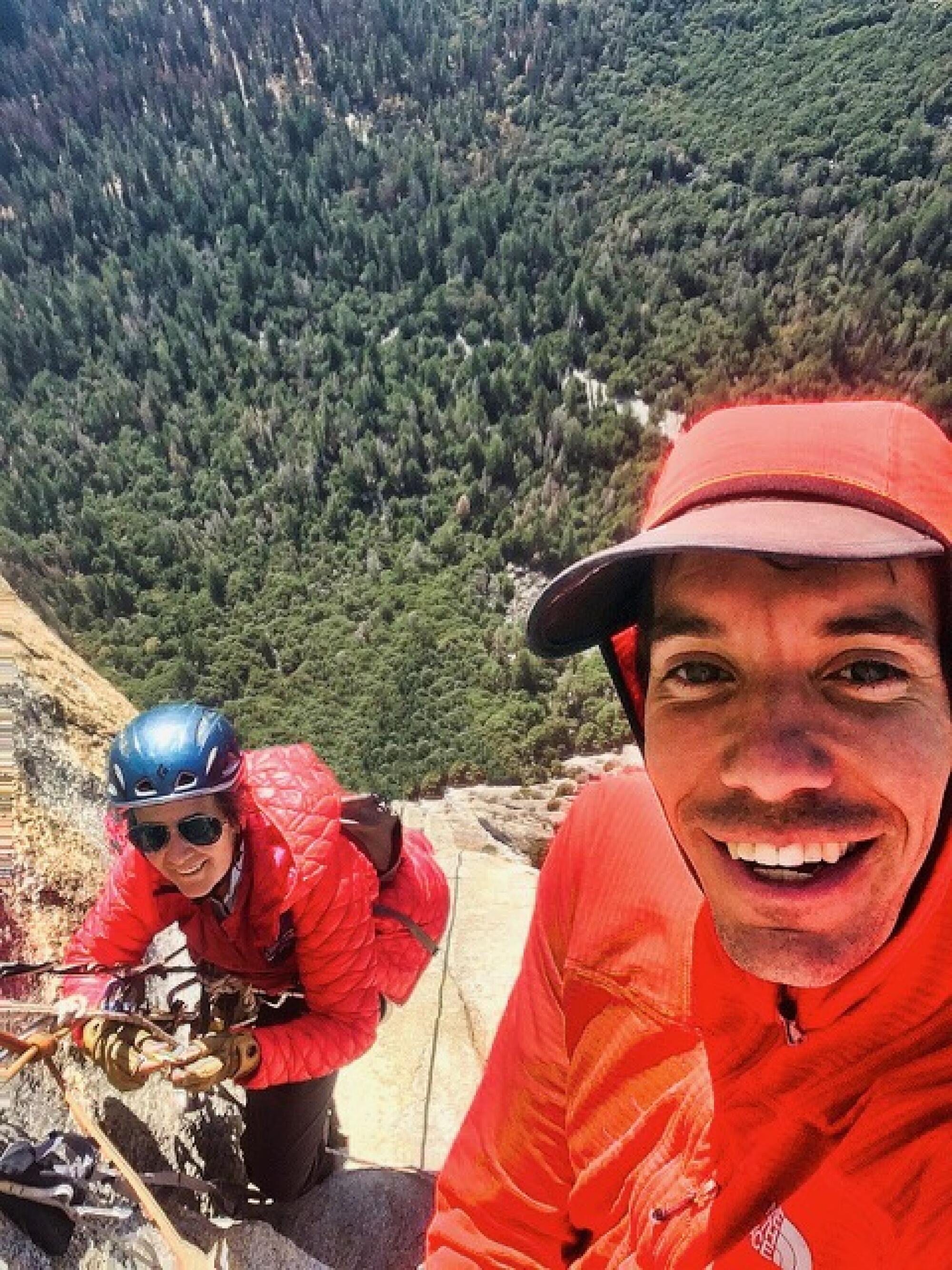
Honnold said he has been routinely impressed by his mother’s “determination, her willingness to just keep trying and to keep pushing. ... Somehow she always makes it work.”
But will he worry when she takes to El Capitan next month?
Not at all, says the man whom fellow climbers nicknamed “The Monk,” for his climbing devotion and stoicism.
“She might get tired. Or the conditions might not be safe. But I do feel it’s a guarantee that she will be safe doing it,” Honnold said. If it doesn’t work out at that time, he said his mom will have other opportunities to get on El Cap. “That’s the beauty of climbing. The mountain will always be there.”
More to Read
Sign up for Essential California
The most important California stories and recommendations in your inbox every morning.
You may occasionally receive promotional content from the Los Angeles Times.

